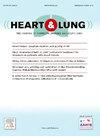Comparing perceptions of leading causes of death in a diverse sample of community-dwelling women in the United States
IF 2.4
4区 医学
Q2 CARDIAC & CARDIOVASCULAR SYSTEMS
引用次数: 0
Abstract
Background
Heart disease is the leading cause of death (LCOD) for women in the United States. However, despite decades of public health campaigns, awareness of heart disease among women, especially those with racial/ethnic minority backgrounds and young women, significantly declined from 2009 to 2019.
Objectives
The aim of this study was to compare the differences in heart disease awareness as the LCOD among Black, Hispanic, White, and Asian/Other women groups.
Methods
In this cross-sectional, online survey study, 422 community-dwelling women were analyzed. Heart disease as the LCOD was categorized as the correct answer. We implemented log-linear models via a Poisson regression to estimate unadjusted and adjusted relative risks [RRs] of race in predicting correct knowledge of LCOD.
Results
The mean age was 41.2 (±12.9) years. The sample represents 39.8 % Hispanic, 28.4 % White, 19.9 % Black, 11.9 % Asian/others. After adjusting for age and cardiovascular disease risks, Black and Hispanic women, as compared to White women, had significantly lower awareness of heart disease as the LCOD [(Adjusted RR=0.69, 95 % CI: 0.52, 0.92); (Adjusted RR= 0.78, 95 % CI: 0.78 -0.94), respectively]. Additionally, physical inactivity and hypertension medication intake were significantly associated with this level of awareness (P < 0.5).
Conclusion
Lower heart disease awareness in Black and Hispanic women persists. It is crucial to develop more effective approaches to close this disparity. Testing new methods, such as applying artificial intelligence to send more culturally appropriate and personalized messages, is urgently needed to raise women's awareness of their heart disease risk.
比较美国不同社区妇女对主要死亡原因的看法
背景:心脏病是美国女性死亡(LCOD)的主要原因。然而,尽管开展了数十年的公共卫生运动,但从2009年到2019年,妇女,特别是具有种族/少数民族背景的妇女和年轻妇女对心脏病的认识显著下降。目的:本研究的目的是比较黑人、西班牙裔、白人和亚洲/其他女性群体的LCOD在心脏病意识方面的差异。方法在这项横断面在线调查研究中,对422名社区妇女进行了分析。心脏病作为LCOD被归类为正确答案。我们通过泊松回归实现对数线性模型来估计未调整和调整的种族相对风险[rr],以预测正确的LCOD知识。结果患者平均年龄41.2(±12.9)岁。样本中西班牙裔占39.8%,白人占28.4%,黑人占19.9%,亚洲/其他族裔占11.9%。在调整了年龄和心血管疾病风险后,与白人女性相比,黑人和西班牙裔女性对LCOD为心脏病的认识明显较低[(调整后RR=0.69, 95% CI: 0.52, 0.92);(校正后RR= 0.78, 95% CI: 0.78 -0.94)。此外,缺乏运动和高血压药物摄入与这种意识水平显著相关(P <;0.5)。结论黑人和西班牙裔妇女的心脏病认知度持续较低。制定更有效的办法来缩小这一差距至关重要。迫切需要测试新方法,例如应用人工智能来发送更具文化适应性和个性化的信息,以提高女性对心脏病风险的认识。
本文章由计算机程序翻译,如有差异,请以英文原文为准。
求助全文
约1分钟内获得全文
求助全文
来源期刊

Heart & Lung
医学-呼吸系统
CiteScore
4.60
自引率
3.60%
发文量
184
审稿时长
35 days
期刊介绍:
Heart & Lung: The Journal of Cardiopulmonary and Acute Care, the official publication of The American Association of Heart Failure Nurses, presents original, peer-reviewed articles on techniques, advances, investigations, and observations related to the care of patients with acute and critical illness and patients with chronic cardiac or pulmonary disorders.
The Journal''s acute care articles focus on the care of hospitalized patients, including those in the critical and acute care settings. Because most patients who are hospitalized in acute and critical care settings have chronic conditions, we are also interested in the chronically critically ill, the care of patients with chronic cardiopulmonary disorders, their rehabilitation, and disease prevention. The Journal''s heart failure articles focus on all aspects of the care of patients with this condition. Manuscripts that are relevant to populations across the human lifespan are welcome.
 求助内容:
求助内容: 应助结果提醒方式:
应助结果提醒方式:


